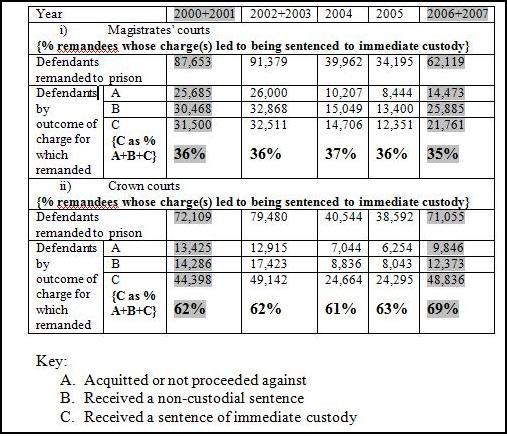Magistrates’ costly decisions on whom to remand to prison
Ten of thousands of people are remanded in custody every year while they await trial. But when they come to court, a high proportion walk free.
They are either acquitted, not proceeded against, or given a non-custodial sentence, but receive no compensation for time spent on remand. In the interests of justice, we ought to know more about of these remandees, but despite suggestions from Andrew Pelling MP, the Ministry of Justice has proved resistant to the idea of undertaking a regression analysis to identify their characteristics.
What is needed is a comparison of the three classes of remandees who were subsequently (A) acquitted or not proceeded against or (B) received a non-custodial sentence versus (C) received a sentence of immediate custody. An obvious first characteristic to consider is the type of court because, in general, custodial sentences are a more likely outcome at the Crown court than in magistrates’ courts.
To prove the point about possible explanatory factors, I therefore asked the Secretary of State for Justice, Jack Straw, to make information on remandees available by type of court. The results, see Table below, are striking.

Magistrates’ courts. The number of remands by magistrates’ courts decreased dramatically, by 29 per cent, between 2000+2001 (87,653) and 2006+2007 (62,119) Subtotal C of remandees subsequently sentenced to immediate custody by magistrates decreased commensurately, by 31 per cent, from 31,500 to 21,761, over the same period.
Subtotal B of remandees subsequently given a non-custodial sentence decreased more modestly by 15 per cent (30,468 to 25,885). The greatest fall was for remandees who were subsequently acquitted or not proceeded against, which dropped by 44 per cent (25,685 to 14,473).
Thus, over the period 2000+2001 to 2006+2007, there has been a marked decrease in the absolute number of A+B remandees who were subsequently acquitted, not proceeded against or given a non-custodial by magistrates. But, the proportion of magistrates’ remands that subsequently received an immediate custodial sentence (C) has remained low: typically, 36 per cent.
In 2006+2007, magistrates may have requisitioned an annual average of 0.5×55×40,358 = 1,109,845 prisoner-days = 3,040 prisoner-years, or five medium sized jails for persons who subsequently did not receive a custodial sentence. (This is based on previous answers showing that the average time on remand is 55 days. These prisoners, unlike those whose offence warrants immediate custody, receive no relief for their time spent on remand.
Crown courts. The number of Crown court remandees was only slightly lower at 71,055 in 2006+2007 than it had been in 2000+2001 (72,109) but had risen in the intervening years.
Subtotal C of remandees subsequently sentenced to immediate custody by the Crown courts increased from 44,398 in 2000+2001 to 48,836 in 2006+2007 - representing an increase in the proportion of Crown court remands that resulted in an immediate custodial sentence from 62 per cent to 69 per cent.
As in the magistrates’ courts, the greatest reduction was for Crown court remandees who were subsequently acquitted or not proceeded against. Their number, A, dropped by 27 per cent from 13,425 in 2000+2001 to 9,846 in 2006+2007.
So in 2006+2007, the Crown courts may have requisitioned an annual average of 0.5×55×22,219 = 611,020 prisoner-days = 1,670 prisoner-years, or 2.8 medium sized jails for persons who subsequently did not receive a custodial sentence.
Summary: In 2006+2007, those remanded to prison by magistrates’ courts had a low 36 per cent chance of getting a custodial sentence, the length of which would be reduced by their days spent on remand. However, 64 per cent of those remanded to prison by magistrates got no sentence relief for having been remanded, or indeed no sentence at all!
By contrast, in 2006+2007, those remanded to prison by the Crown court had a high 69 per cent chance of getting a custodial sentence.
It should be a priority for the Ministry of Justice to collect and publish statistics on the mean time spent on remand for each of subgroups A to C of remandees by i) magistrates’ courts, ii) Crown courts.
Footnote: the most recent counts received from the MOJ differ in detail but not substance from earlier postings. We assume that the latest counts are the most rigorous.




Jake Grey (not verified) wrote,
Wed, 09/12/2009 - 20:55
Small point of clarification. Are persons convicted but then released as time served on remand equaled the maximum possible custodial sentence included in Category A, B or C?
Mark Henderson (not verified) wrote,
Sun, 20/12/2009 - 20:43
In 2003 I was wrongly convicted of an assault (sect 47 oapa) of a non-medicinely compliant paranoid schizophrenic, using amphetamine recreationally, and attempting to pervert the course of justice by writing to the family asking their intervention. Because I was held on remand I was prevented from proving my innocence and was wrongly convicted and sentenced to 7 years in prison.
The prosecution case was based on the testimoney of the registered care in the community patient as were they normal.
The defence was that as a consequence of being present when the patient became psychotic, it was necessary to use resonable and minimal force in restraint resulting in some minor injury, for the safety of the patient.
The case is currently being assessed by the Appeal Courts.